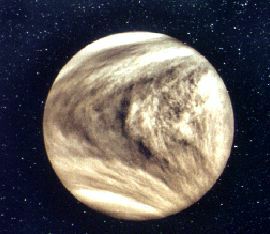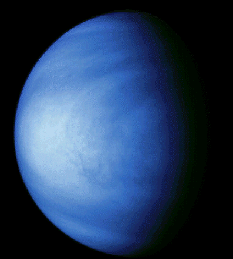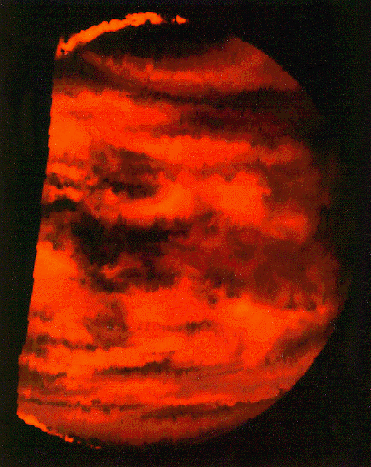 Missions to the
surface of Venus (Russian Venera spacecraft) indicate that the cloud deck
begins about 50 km above the surface.
Missions to the
surface of Venus (Russian Venera spacecraft) indicate that the cloud deck
begins about 50 km above the surface.
 Missions to the
surface of Venus (Russian Venera spacecraft) indicate that the cloud deck
begins about 50 km above the surface.
Missions to the
surface of Venus (Russian Venera spacecraft) indicate that the cloud deck
begins about 50 km above the surface.
There are 3 cloud layers, the highest extends from 58-68km above the surface, the middle from 52-56km and the lowest from 48-52km. The density decreases the higher above the surface one goes. Haze extends to about 33 km from above and below that the air is largely clear.
The cloud layers are stable because the circulation in the atmosphere is more regular than that on the Earth. In particular, because the rotation of Venus is so much slower, a single region, called the SUBSOLAR POINT, gets more directly illuminated by the sun for a longer period than for the Earth. As the atmosphere is heated, hot air rises and spreads out in the upper atmosphere. While not fully understood, the subsequent convection leads to the 300km/hr jet streams in the upper atmosphere. The Y-pattern in UV images shows this wind pattern.
Because the Earth is rotating faster than Venus, one can understand that the subsolar point for the Earth changes more quickly for Earth. This means that no sooner does the convection of upward moving gas begins for one region, as the sun begins illuminating above another spot, and thus generating convection at another location. The interaction between these mutliple convection zones in the Earth likely leads to the more complicated atmospheric motions on the Earth than on Venus.
Note also that on Venus, the atmosphere seems to orbit in only 4 days above the much more slowly rotating planet.
Vega satellites studied this winds by dropping a balloon instrument into the atmosphere floating at 55km. The ballons survived 46 hours and were blown around 1/3 the circumfernce of the planet.
Spectral analysis of the thick cloud layer surrounding Venus suggests that the clouds are largely composed of sulphuric acid droplets. The cloud layer is rather featureless in visible light, but shows structure in other wavelengths. The adjacent image shows the clouds photographed by Pioneer 10 at UV wavelengths and computer enhanced to accentuate differences.
Different wavelengths of light penetrate the atmosphere to varying degrees
and therefore may be used to study different layers of the clouds and
atmosphere. For example, the following images show the clouds of Venus imaged
in visible light (with a violet filter), ultraviolet light, and infrared light
respectively.
 |
 |
 |
| Visible Light (Ref) | Ultraviolet (Ref) | Infrared (Ref) |
Here is a more detailed discussion of the infrared imaging from the Galileo spacecraft shown in the right photograph, including an explanation of the "false color" used in such images.